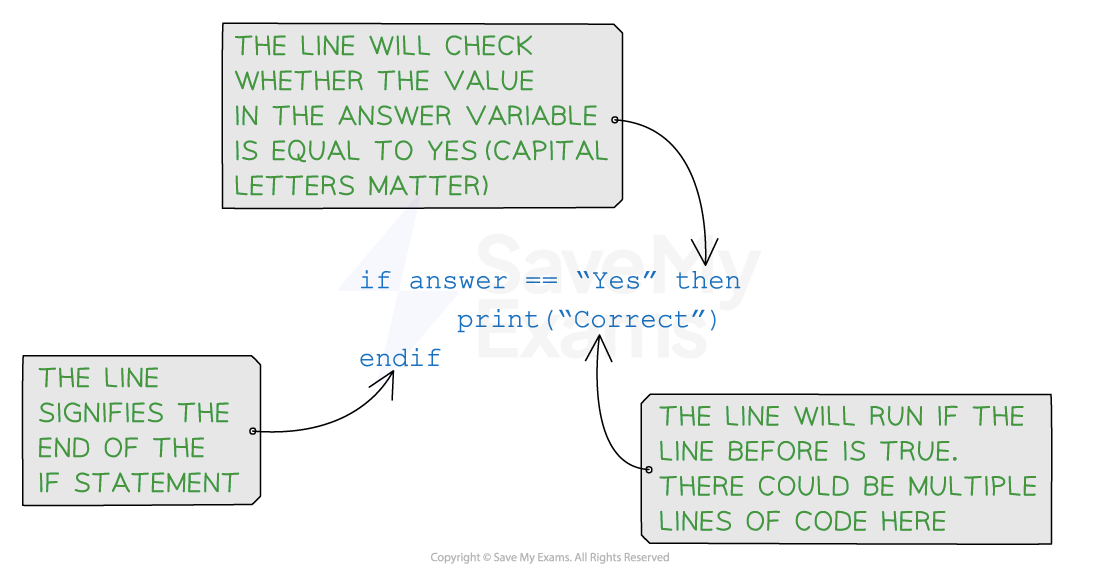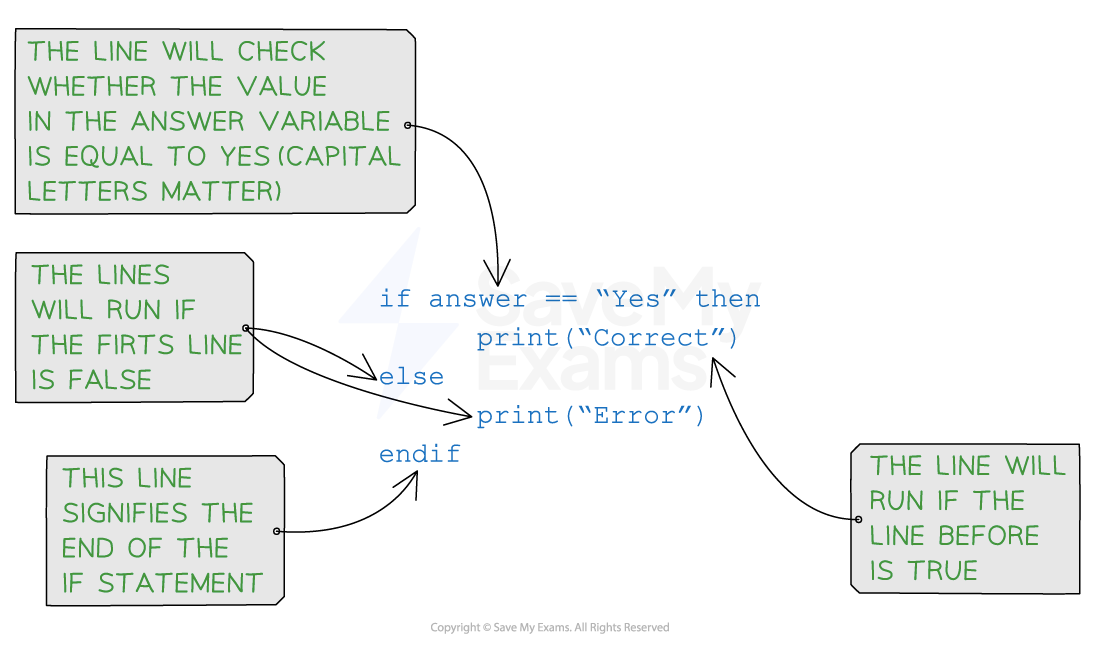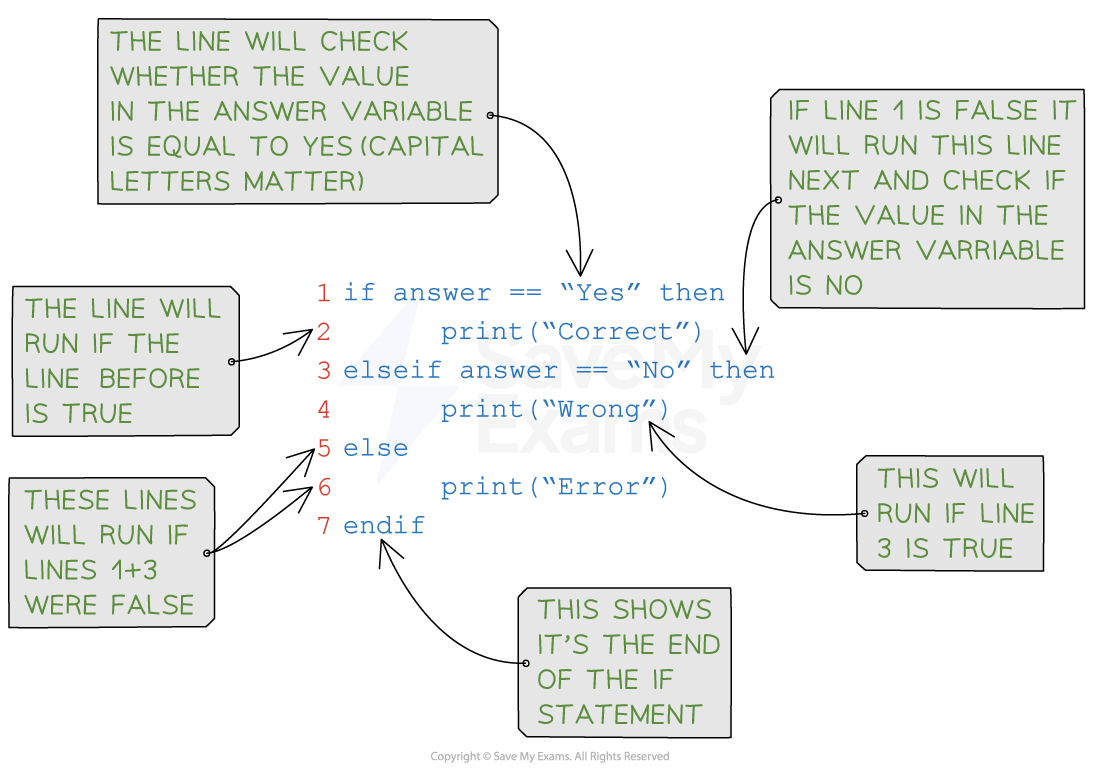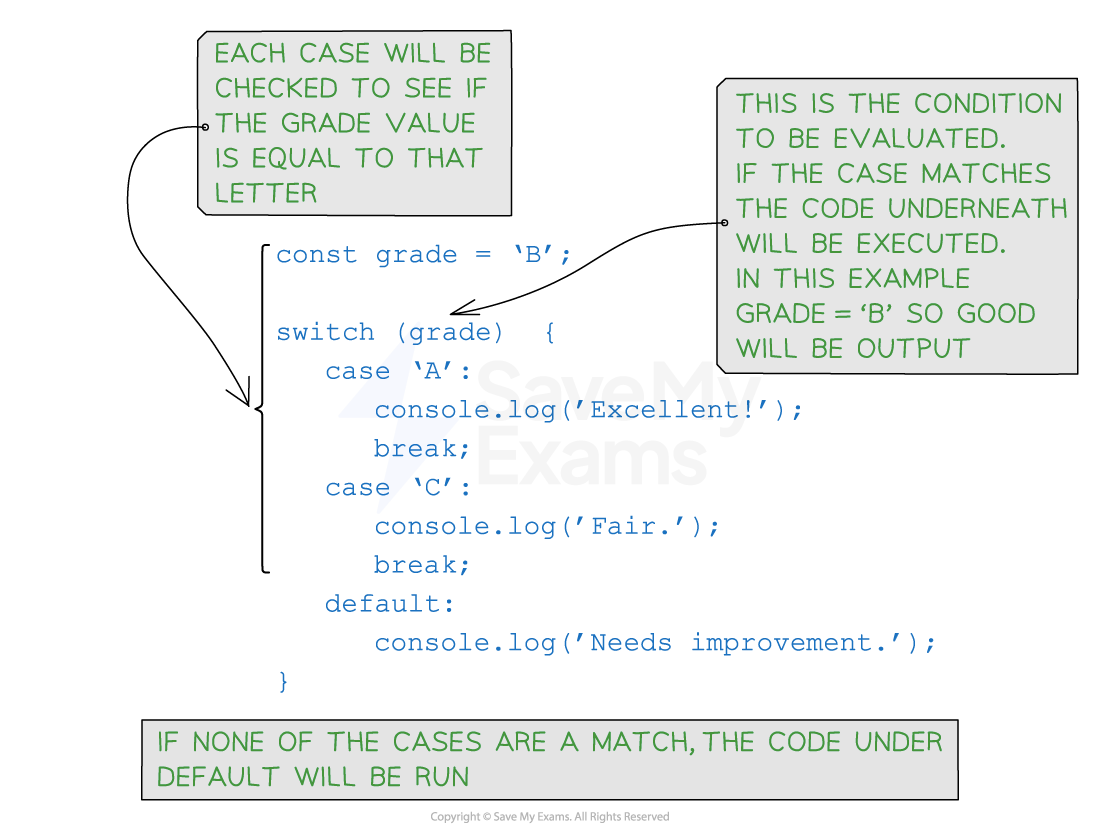Selection in JavaScript (OCR A Level Computer Science): Revision Note
Exam code: H446
Selection in JavaScript
Programming code is made up of constructs which control the flow of a program
Constructs tell the computer the order in which to carry out the statements/lines of code
There are 3 programming constructs:
Sequence
Selection
Iteration
Selection is selecting a line/lines of code to run depending on whether a condition is true or false
There are two ways to write selection statements:
IfstatementsSwitch casestatements
When writing a condition there will need to be a comparison operator. They are listed below:
Operator | Description | Example (where x=5) | Returns |
|---|---|---|---|
== | equal to | x == 8 | false |
x == 5 | true | ||
x == "5" | true | ||
=== | equal value and equal type | x === 5 | true |
x === "5" | false | ||
!= | not equal | x != 8 | true |
!== | not equal value or not equal type | x !== 5 | false |
x !== "5" | true | ||
x !== 8 | true | ||
> | greater than | x > 8 | false |
< | less than | x < 8 | true |
>= | greater than or equal to | x >= 8 | false |
<= | less than or equal to | x <= 8 | true |
IF Statements in JavaScript
An
if thestatement will let you choose a line/lines of code to run if a condition is true or falseBelow are three examples of
ifstatements:
ifif elseif else if else
Syntax of an if statement
The syntax of an if the statement consists of the if keyword, followed by a condition enclosed in brackets, and a code block that is executed if the condition evaluates to true:
if (condition) { // Code to be executed if the condition is true}
Pseudocode example of an if statement

Example in JavaScript: checking if a number is positive
const number = 5;
if (number > 0) { console.log('The number is positive.');}
In this example, the
ifstatement checks if the value of the variablenumberis greater than0. If the condition is true, the message'The number is positive.'is output to the browser
Syntax of an if-else statement
The if the statement can be extended with an else clause to specify an alternative block of code that is executed when the condition evaluates to false:
if (condition) { // Code to be executed if the condition is true} else {
// Code to be executed if the condition is false
}
Pseudocode example of an if-else statement

Example in JavaScript: Checking if a number is positive or negative
const number = -3;
if (number > 0) { console.log('The number is positive.');} else { console.log('The number is not positive.');}
In this example, if the value of
numberis greater than0, the message'The number is positive.'is output. Otherwise, the message'The number is not positive.'is output
Syntax of an If Else-If Else statement
The else if the clause specifies additional conditions to check if the initial if condition is false. This allows the handling of multiple scenarios in a more complex decision-making process:
if (condition) { // Code to be executed if the condition is true} else if (condition) {
// Code to be executed if the condition is true} else {
// Code to be executed if the condition is false
}
Pseudocode example of an If Else-If Else statement

Example in JavaScript: Grading a score
const score = 85;
if (score >= 90) { console.log('Excellent!');} else if (score >= 80) { console.log('Good.');} else if (score >= 70) { console.log('Fair.');} else { console.log('Needs improvement.');}
In this example, the
if-else if-elsestatement evaluates the value ofscoreto determine the corresponding message based on the score range
Examiner Tips and Tricks
You can use as many
else ifs as you want to within yourifstatement but it might be clearer to use aswitch casestatementYou can have an
if else-ifstatement without an end as the catch-all condition at the end
How do I write my condition?
Think of it like writing a yes/no question
E.g.
Is the number bigger than 10?
Is the number between 50 and 100?
Is the answer Paris?
If the question can’t be answered with yes/no then it needs to be rewritten in this way
Is it possible to use more than one operator?
Yes! Using one operator is most common but sometimes 2 are needed. More than 2 could be used but it gets more complicated. This involves using boolean operators
Imagine a program where the user has to enter a number based on the role of a dice. The number needs to be between 1 and 6
The yes/no question could be is the number between 1 and 6 - but it would be structured slightly differently in the code
IF number >=1 AND number <=6 thenThe first check is if the number is greater than or equal to 1
The second check is if the number is less than or equal to 6
The final check is if both sides are True
Examiner Tips and Tricks
Check whether to use an
ANDor anORin the condition - it’s easy to get these 2 mixed up. E.g.IF number<0 AND number>100will check if the number is below 0 and greater than 100 (there are no numbers which fit into this range!)IF number<0 OR number>100will check if the number is between 1 and 99
Worked Example
A website sells tickets for sporting events. The website uses HTML, CSS and JavaScript. The website charges a booking fee of £2.99 on each ticket sold. In addition, if the tickets are purchased from outside of the UK, £4.99 is added to the booking fee. The booking fee is calculated using a JavaScript function named bookingfee().
Complete the definition of the bookingfee() function below.function bookingfee(numtickets, country) { var nonUKprice = 4.99; var perTicketPrice = .............................................; var total = 0; if (country!="UK") { total = total + .............................................; } total = total + (............................................. * perTicketPrice); return total;}
3 marks
How to answer this question:
The first blank space is to set the value of the
perTicketPrice. The question tells us this is £2.99The 2nd blank space is to add something to
totalif the country is not equal to UK. The question tells us that if the tickets are purchased from outside the UK, £4.99 is added to the booking fee. This is stored in thenonUKpricevariableThe 3rd blank space is something multiplied by
perTicketPrice. The question tells us each ticket is £2.99 so we need to multiply theperTicketPriceby the number of tickets (callednumtickets)
Answer:
Example answer that gets full marks:
function bookingfee(numtickets, country) { var nonUKprice = 4.99; var perTicketPrice = 2.99; var total = 0; if (country!="UK") { total = total + nonUKprice; } total = total + (numtickets * perTicketPrice); return total;}
Examiner Tips and Tricks
When you're given code in a question that you need to refer to or complete, you must spell existing identifier names exactly as they have in the question. E.g. if you write
numtiketsinstead ofnumticketsyou won't get the markAlso, make sure you don't include £ in the calculation - this will be added as an output and will cause the calculation to not work as it's included a character that's not an integer
Switch Case in JavaScript
Switch Caseis a type of conditional statement that provides an alternative way to perform multiple comparisons based on the value of an expressionThese statements are particularly useful when you have a single expression that you want to compare against multiple possible values
Syntax of a Switch Case statement
The syntax of a
switch casestatement consists of theswitchkeyword followed by an expression enclosed in bracketsThis expression is evaluated, and its value is then compared against various
caselabels. If a match is found, the corresponding block of code is executedThe
defaultkeyword is optional and specifies a block of code to be executed if none of the case labels match the expression:
switch (expression) { case value1: // Code to be executed if the expression matches value1 break; case value2: // Code to be executed if the expression matches value2 break; // more case statements default: // Code to be executed if no case matches the expression}
Switch case example in JavaScript: Grades evaluation

Fall-Through behaviour
By default, switch case has a fall-through behaviour, meaning that if a case label matches, the code execution continues to the next case until a break statement is encountered. This allows you to group multiple cases with the same code:
const day = 'Monday';
switch (day) { case 'Monday': case 'Tuesday': case 'Wednesday': case 'Thursday': case 'Friday': console.log('Weekday'); break; case 'Saturday': case 'Sunday': console.log('Weekend'); break; default: console.log('Invalid day.');}
In this example, if
dayis 'Tuesday', 'Weekday' is logged to the console because it falls through the cases of 'Monday' to 'Friday' until abreakstatement is encountered

Unlock more, it's free!
Did this page help you?